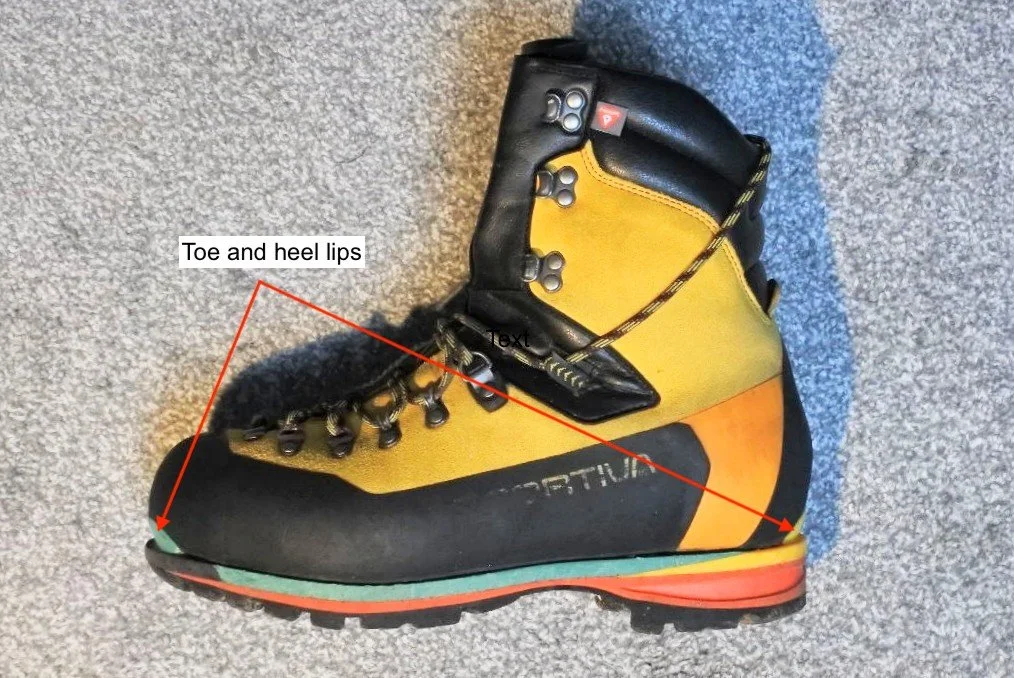Winter Kit Considerations
Choosing the right kit for winter walking in Scotland can be complicated and time consuming. What’s a B2 boot? Which crampon will fit to it? How long does my axe need to be? What emergency kit should I carry? And the list goes on.
This blog aims to make your kit selection a little more straight forward with a few tips from my own personal experience thrown in for good measure.
Winter Boots
Summer Vs Winter
Summer boots usually have a relatively soft and flexible sole, are lightweight and offer insulation good enough to deal with summer temperatures. In contrast winter boots are designed to have stiff, if not completely rigid soles, so that they can fit crampons without them falling off. This, combined with their extra insulation, means that they feel heavier and a more cumbersome to walk in.
The fit is slightly different from your summer boot also from brand to brand so it’s always worth going and getting advice from your local outdoor shop before buying.
Different Winter Boot Types
B1
Small flex in the sole.
No lip at either end of the boot to clip your crampon into.
Least insulated of the three.
Designed to be able to be used in both summer and winter.
Aimed at less technical terrain for occasional winter walkers.
B2
Maybe a tiny bit of flex in the sole if not rigid.
Lip at the heel of the boot to fit a crampon.
Mid-range insulation – good for Scottish winter or summer in the Alps.
The type of boot that we recommend for Scottish winter walking.
B3
Completely rigid sole.
Lips at both the toe and heel of the boot.
Most well insulated of the three.
Designed for technical winter climbing, winter alpine/high alpine environments.
Crampons
Crampons are a vital bit of kit to have in your winter arsenal. Amongst other things they allow safe passage on snow, ice and rock. The spikes are designed to bite into hard snow, ice and slippery rock where a normal winter boot sole could not. The different types handily correspond to the boot classification system:
C1
Designed to strap to boot.
Good for UK winter hill walking.
Fit B1, B2 and B3 boots.
C2
Clips to the lip at the heel of your B2 boot.
Good for winter walking, scrambles and low grade climbing.
Fits B2 and B3 boots
What we recommend to go with your B2 boots.
C3
Clips to both the front and back lips of a B3 boot.
Designed for technical winter climbing.
Ice Axe
The ice axe is a wonderfully versatile bit of kit. They’re most often used to provide stability when moving on snow.
When choosing your ice axe you should consider the length, a general rule is that the spike should reach the top of your boot when holding the axe from the pick (top) with your hands relaxed down by your side. Some, generally more technically shaped axes, have the option to choose a hammer attachment rather than an adze. These are designed to hammer gear into rock on climbs/scrambles so won’t be required for winter walking.
Different types
Walking Axe
These are ideal for winter walking.
We recommend!
Mountaineering Axe
The curve in the shaft gives you a better swing into snow.
Used for alpine mountaineering or low grade winter climbing/scrambling.
Technical Climbing Axe
Aggressively curved and mostly used as a pair for technical climbing and mountaineering.
Note the hammer attachment where the adze should be.
Other Kit Tips
Goggles – To be carried whenever you go out winter hill walking. You’ll know why if the wind’s blowing snow into your face!!
Gloves – I carry a thin pair, a thick pair and mits, plus spares!
Rucksack – Typically 40 litres is good, remember you have to carry extra clothing and crampons plus a helmet if you’re attending a course!
Belay jacket – I use a synthetic (not down) jacket that I can throw on over the top of all of my other layers.
Gaiters – A whole day of clearing snow out of the inside of your boot’s not a good look!
Walking poles – When an ice axe isn’t needed and especially in deep snow walking poles are invaluable. I carry two.
Snacks - Take snacks with you that are easy to eat with gloves on. Your hands get cold fast!
Emergency - I always carry a bothy bag/group shelter and a sit mat whether I’m with a group or not. If you can’t find shelter from the wind they can keep you from getting very cold and compare sitting directly on the snow with having a thin layer of insulation between you and the snow and you’ll know why!
I hope that this article provides some insight into considerations for winter kit. If you have any questions please comment below or contact us here. This is just part of what’ll be covered on one of our Winter Skills Courses.
Click here to find out more and book on!
Written by Edd Hamilton










